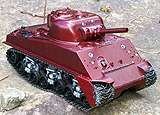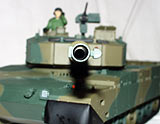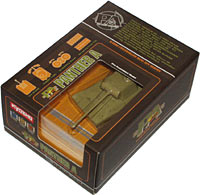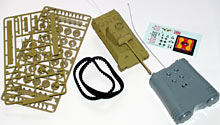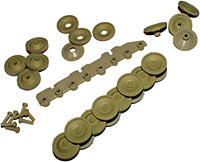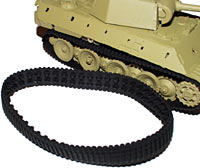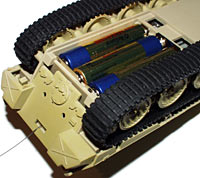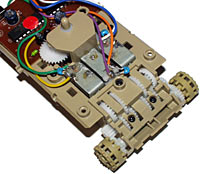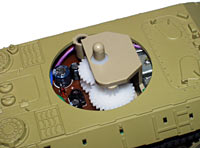
Kyosho Pocket Armour Panther A
Review date: 4 May 2001.Last modified 03-Dec-2011.
Daddy tank.
Mummy tank.
And now, little baby tank.
The scintillatingly beautiful, windswept and interesting staff of HobbyLink Japan have demonstrated their ineffable marvellousness by sending me a Kyosho Pocket Armour model.
It's a model - and a good one - of the German WWII Panzerkampfwagen V, or "Panther" tank. The Ausführung A version, to be exact, which came after the original Ausf. D; the odd letter progression probably had something to do with people being too busy doing horrible things to other people to apply their usual Teutonic efficiency to their product naming.
Anyhow, the Panther was arguably the best tank the Germans had - smaller than the lumbering Tiger I and even more ponderous Tiger II, but more nimble than the heavy tanks, while still being formidably armed and armoured.
The real thing weighed 43 tonnes and was 6.88 metres long not including the gun; the model's about 120mm long, and weighs... well, it doesn't weigh much, OK?
The Sherman (the red one) is the smallest of these tanks in real life, but this model is 1/16th scale. The JGSDF Type 90's the biggest in real life, but the model's only 1/24th scale. The Panther A is about 1/56th scale, I think.
The Pocket Armour range are all tiny little tanks, both WWII and modern models. They all have rubber tracks and non-proportional button-based remote controls. But they are, nonetheless, real live radio controlled tanks. And their scale detail is surprisingly good, despite their tiny size.
The price tag
HobbyLink Japan is one of the few Japanese hobby product suppliers that ships to foreign buyers; that's their whole schtick. They mainly sell plastic models that are hard to find outside Japan, but they do radio controlled gear as well.
Shipping a lot of hobby products from Japan to the USA or to Australia, where I am, is generally fairly pricey. The boxes usually don't weigh a ton, but they're big.
The Pocket Armour tanks come in a nice little box, though, and shipping to Australia was only 1280 yen. Which is about $AU20, or $US10, as I write this. The tank itself is selling for 6240 yen (on special, regular price 7800 yen), so the whole landed price for one of these things in Australia is only $AU120 or so.
Now, $US60-odd may be a fairly hefty price for an R/C toy you really could stick in your pocket, but by model tank standards, it's nothing.
The Tokyo Marui tank I review here came from HobbyLink Japan as well, and cost 14,800 yen plus shipping; the landed price for that tank and One Quantity of ammunition (because it, ah, shoots...) worked out at easily three times the price of the little Kyosho.
And the Marui tank's a cheap one, with no real off-road capability to speak of. The base price for a Tamiya 1/16th scale tank kit (you assemble it yourself, naturally!) is $US400, for the Sherman I review here, or a whopping $US670 for the Tamiya Tiger 1 with super-fancy light-and-sound package.
HobbyLink Japan have the Tamiya tanks, but people in most countries can get them locally and not have to shell out zillions for shipping. You'd really only need to buy from Japan if you just had to have something like the upcoming Sherman with Tiger-style light-and-sound package before anybody else.
Frankly, you don't even want to know what large-scale model armour costs.
So let's forget about the money, for the time being, shall we? Your crazy old uncle left you $US60 on condition that you spend it on a model tank, OK?
Let's get on with the playing.
What you get
Just looking at the box, you might think the Panther came ready to roll.
It doesn't. But it's not much trouble to assemble - all you have to do to get it going is build up the road wheel sets, pop on the tracks, and stick in some batteries.
All of the parts come on the usual plastic-model frames of moulding sprue; you clip them off with side cutters. And then clean up the little nub of sprue left on the part, if you're into scale perfection. Or don't, if you're not.
The road wheels are actually rather nice. This Panther is a "High Grade" Pocket Armour model, which means that it comes with road wheels that actually turn (ooh, luxury!), and also has a traversing turret. Of which more in a moment.
The road wheels seem to be pretty much completely scale, which is quite impressive. Most cheap models of tanks like the Panther don't bother with full road wheels, because there are three overlapping ranks of wheels, and the inner ones can't be seen unless you're peering under the model. They're all there on this tank, though.
There's no suspension - with rubber tracks, it'd be pretty much a waste of time even if you could cram the torsion bar system into a model this small - but the track setup nonetheless looks tasty.
Cheap model tanks all have rubber tracks. They never work very well.
If they're really tight, the motors use most of their power straining to turn the tracks. If they're really loose, they walk peacefully off the guide sprockets all the time.
The Panther's tracks are quite loose, but the scale side skirts (not yet applied, in the above picture) help to hold them in place, and I found a few squirts of silicone oil on the inside of the track helped them stay on the sprockets. A tank this tiny will throw a track if it gets a decent-sized dust bunny caught in the sprocket, of course, but I've seen tiny motorised tanks that work much worse than this one does.
Three AAA cells power the tank (you can see the on-off switch at left of frame); the transmitter uses a single 9V battery.
Once you've got to the tracks-and-batteries stage - which only takes about an hour, tops - the tank can drive around. If you want to make it look a bit more realistic, though, you'll want to attach the various scale detail parts and decals.
Some of the parts are a perfectly good friction fit; some need a dab of glue. The standard small-model technique of applying glue with a toothpick lets you easily stick everything on without creating any unsightly adhesive puddles under things.
If you're a real scale enthusiast, you'll want to paint the parts before you attach them. I'm not, so I just stuck 'em in place.
The tank comes with a little commander figure - well, a half-figure, really; he sticks up through the hatch and has no legs. He would have looked silly in plain olive drab plastic, so I left him out, and put the hatch piece in the closed position instead of the open one. The hatch is one of the friction-fit pieces, so I can add the miniature German later should I so desire.
Some of the Panther's decals seem to have been created by Kyosho purely to make clear to you that anything you previously considered to be small was, in fact, very large indeed. The little black bits on the end of the gun that give the impression that it has a bore, for instance, are decals; the smallest of them has a total surface area of about five square millimetres. But I'm a decal klutz, and I still managed to get them pretty much right.
The Panther's assembly instructions are all in Japanese, but the illustrations are good. I'm pretty sure I was meant to put some decals behind some other ones in places, but I didn't. Sue me.
Driving it
The Pocket Armour transmitter's a simple enough thing - the four buttons in the middle are forward and back controls for the tracks on either side, and the index-finger shoulder buttons control the turret traverse. The gun can elevate as well, but only if you push it manually; its standard setup is floppy so it won't stay elevated, but you could easily stiffen it up.
So how fast is it?
Well, not very.
Model tanks are not built for speed. Proper articulated-track models can have a scale speed faster than the full-scale original - if the full-scale tank can do 50km/h and a 1/10th scale model can do 6km/h, it wins for scale speed - but none of them are fast enough to get away from an operator with functioning legs.
Rubber-track model tanks are even slower than articulated-track ones, and really tiny ones like the Pocket Armour tanks could just about win a race with a pet tortoise.
The Panther, making its very finest two-little-motors-with-lots-of-gears noise, does about 0.3km/h, which is roughly 0.2mph. It'd storm down the quarter mile in an hour and 20 minutes, possibly not including a battery change or three.
It's also not got a lot of power. On a smooth, flat surface it's fine, and can steer around by stopping one track and driving the other, or by pirouetting (driving tracks in opposite directions). It can struggle up a slope it gets some traction on, too; on something like rough particle board, it can climb a 40 degree incline.
The turret traverse interferes with the motor drive; you can't drive straight and turn the gun at the same time. But apart from that, it's easy to get the hang of.
Put the tank on any sort of carpet, though, and it has a hard time turning. On anything rougher than short-pile carpet, it's not going anywhere at all.
This is a desktop ranger, basically.
Within its limitations, though, the Pocket Armour tank is surprisingly fun to drive. OK, it can't grind across a shaggy lawn like my steel-tracked Sherman can, but it costs about an eighth as much. Whaddaya want.
The turret can rotate a full 360 degrees; the gun just nudges the antenna out of the way as it passes it. The base of the turret occasionally snags on the top of the tank's hull, but if that happens no harm's done; the loose press-fit mounting for the turret just spins. A little work with some fine emery paper on the bottom edge of the turret would probably cure the problem.
Giblets
Inside the Panther (you can only undo its four case screws if the road wheel assemblies aren't attached), the few components are tightly packed.
The heavy gear reduction from the tiny motors to the sprockets and turret drive is neatly compressed into the small space available - the total width of the tank is only barely over six centimetres. There's still room for anti-noise capacitors on the tiny motors, though; they help prevent brush sparking from interfering with the radio signal.
With the chassis screwed together, it's still easy to pull off the turret and reveal the press-fit mount.
The bottom of the turret drive includes one gear on a very sloppy bearing, which sounds as if it's on the point of death but will probably last forever. It's not as if it's heavily loaded, or anything. I wouldn't be worried about putting a little camera or LED flashlight on top of the turret drive.
And because all of the Pocket Armour tanks' functions are controlled with simple digital switching - they're on or they're off, with no proportional control - they could be an interesting product for robotics enthusiasts. It'd be dead easy to make one of these things computer controlled. And for robotics, a tiny slow chassis can be an advantage, since you can do your experiments on a tabletop!
The Panther uses the 35MHz radio band. As with other cheap R/C gadgets, you can't change the radio frequency for the Pocket Armour tanks, but they come in four frequencies - 27, 35, 40 and 45MHz. You can't get every model in every frequency, though, and models with different frequencies have different colours (the 45 and 57MHz Panthers have camo paint jobs). But it's still not difficult to get three tanks on different frequencies, for multi-lunatic play.
Scale details
Kyosho don't quote the scale of their Pocket Armour tanks on the Japanese-language page about them here (you can plug the URL into BabelFish for a somewhat hilarious translation), but just going by the measurements, this is about a 1/56th scale model.
1:56 isn't a popular scale, as far as I can see; put the Panther next to 1:48 scale models and it'll be a tad small; next to 1:72 stuff it'll look much too big. Model companies commonly take liberties with scale anyway (there is, for instance, "box scale", in which models are sized to fit in a standard cardboard box...), but given the great enthusiasm among military modellers for creating slice-of-life (or death, as the case may be) dioramas, it may matter to some people.
There's a reason for the odd scale, of course; all of the Pocket Armour tanks use the same drivetrain package, so the models all have to be about the same size. I don't think any of them are exactly the same scale.
That said, though, they seem to be consistent, without any of the huge problems that many cheap tank models have - the wrong number of wheels, grossly incorrect dimensions, that sort of thing. Replace the twangy antenna on the Panther with a loop of wire of the same length under the chassis and, painted up nice, it'd fit right into an appropriately scaled diorama.
Options
The rotating road wheels on the "High Grade" Pocket Armour tanks are options on the other ones, but Kyosho, being a serious Japanese model company with a large audience of arguably quite disturbed people, has a couple of other bits and pieces you can add.
You can get a "Hi Mobility Custom Track Set" for a recommended 1500 yen. That contains gives you a rubber-based track with plastic cleats, so it's more flexible and may get better traction, and looks more scale too. It still isn't the equal of a proper chain-link track, but the Japanese Pocket Armour page explains, according to BabelFish, that "In the private belt which becomes the base, it is the assembly type caterpillar set which sticks 1 scene at a time the paint possible resin part."
So that settles it, then.
Also on the above-linked page is a Pocket Armour sized obstacle course set, with "land mine" flippers to punish inaccurate driving. A mere 2800 yen.
Overall
If you're looking for a stormin' off-road all-terrain monster, this little tiddler will disappoint you severely. If you want a desk decoration that can drive around, though, it's another matter. And if you're a modeller, the Panther has sufficient detail to keep you very happy indeed.
If you like the idea of a sharply moulded, quite true scale R/C model tank that's small and cheap enough that you could buy several, and sit them all on the one shelf, then the Pocket Armour range would seem to be just what you're after.
Kyosho's (Japanese) page for the Pocket Armour tanks
Plug the URL into BabelFish for a somewhat hilarious translation ("Does not do either the scarp either the thing.")
HobbyLink Japan no longer sell the Panther A, but they've got one or two other options...
